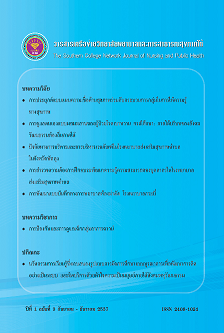การดูแลตนเองแบบผสมผสานของผู้ป่วยโรคเบาหวาน กรณีศึกษา: ภายใต้บริบทของสังคม วัฒนธรรมท้องถิ่นภาคใต้
คำสำคัญ:
การดูแลตนเองแบบผสมผสาน, สังคมวัฒนธรรมท้องถิ่นภาคใต้, การแพทย์ทางเลือก, ภูมิปัญญา ท้องถิ่น, ผู้ป่วยเบาหวาน, Integrated Self-care, Southern Socio-cultural Context, Alternative Medicine, Diabetes Patientsบทคัดย่อ
การศึกษาครั้งนี้ใช้ระเบียบวิธีวิจัยเชิงคุณภาพ มีวัตถุประสงค์เพื่อศึกษาประสบการณ์การดูแลตนเองแบบผสมผสานของผู้ป่วยโรคเบาหวาน ภายใต้บริบทของสังคมวัฒนธรรมท้องถิ่นภาคใต้: กรณีศึกษาตำบลชะแล้ อำเภอสิงหนคร จังหวัดสงขลา เก็บรวบรวมข้อมูลโดยการสัมภาษณ์แบบเจาะลึก (In-depth Interviews) การสังเกตแบบไม่มีส่วนร่วม (Non-participative Observation) การบันทึกภาคสนาม(Field Notes) มีผู้เข้าร่วมวิจัย จำนวน 15 ราย โดยสัม ภาษณ์ตามเกณฑ์การคัดเลือกผู้เข้าร่วมวิจัย วิเคราะห์ข้อมูลโดยการวิเคราะห์เชิงเนื้อหา (Content Analysis)
ผลการศึกษา 6 ประเด็น ดังนี้ 1) การรับรู้ภาวะสุขภาพตนเองในปัจจุบัน ด้านร่างกาย ผู้ให้ข้อมูลส่วนใหญ่สามารถควบคุมน้ำตาลได้ ด้านจิตใจ รู้สึกไม่เครียด ทำใจรับได้แล้ว 2) ความเชื่อเกี่ยวกับสาเหตุการเกิดโรคเบาหวาน ส่วนใหญ่เกิดจากพฤติกรรมการบริโภคอาหาร และความเชื่อเกี่ยวกับการดูแลตนเองเมื่อเป็นเบาหวานแตกต่างกันตามความเชื่อส่งผลให้มีวิธีการดูแลตนเองที่หลากหลาย 3) การดูแลตนเองแบบผสมผสานเมื่อป่วยเป็นโรคเบาหวานเน้นควบคุมอาหาร การออกกำลังกาย ปรับวิธีรับประทานยาให้สอดคล้องกับวิถีชีวิตและงานประจำ และมีการแสวงหาวิธีการดูแลตนเองโดยน้ำสมุนไพรมาทดลองใช้ได้แก่ สมุนไพรเดี่ยว สมุนไพรตำหรับ สมุนไพรผีบอก และมีการใช้การนวดแผนไทยฤาษีดัดตน และโนราบิคส่วนใหญ่ได้รับคำแนะนำจากบุคคลในครอบครัวมากที่สุด ระยะเวลาที่ใช้ ตั้งแต่ 1 เดือน ถึง 8 ปี อุปสรรคที่พบ คือ ข้อจำกัดเรื่องเวลา ภาระงาน รสชาติของสมุนไพร ผลดีที่รับรู้ได้ ส่วนใหญ่ทำให้ระดับน้ำตาลในเลือดคงที่ ผลเสียคือทำ ให้น้ำตาลลดลงมากเกนิ ไป รู้สึก กลัวจึงหยุด ใช้ 4) การมีส่วนร่วมของครอบครัวและสังคมทุกรายได้รับการดูแลอย่างดีจากสมาชิกในครอบครัว 5) การได้รับประโยชน์/ให้ประโยชน์
Integrated Self-Care of Diabetes Patients: A Case Study in the Southern Thai Socio-Cultural Context (Songkhla Province)
Based on qualitative research methods, this study aimed to investigate the experience of people with diabetes mellitus who were taking integrated self-care in the southern Thailand socio-cultural context (tambon Chalae, Singhanakorn district, province of Songkhla). Data were collected by using in-depth interviews, non-participation observations and field notes taking. Participants of the 15 cases were interviewed between November 2009 and June 2010. Data were analyzed using content analysis.
Results revealed six (6) main themes as following.
1. Perceptions of the diabetes patients regarding their own health status were divided into physical and mental health. The majority of the diabetes patients were able to control their blood sugar, accept the illness and cope with stress. Most of them had more than two complications that were hypertension, heart disease, numbness of hands and toes, and eyes blur. They mainly used modern medicine services when a complication occurred.
2. Beliefs about the causes of Diabetes Mellitus: most said that the dietary habits caused Diabetes Mellitus. There were different beliefs about the integrated self-care of participants with diabetes, resulting in a variety of ways to take care of themselves.
3. Integrated self-care of diabetes patients: most of them were strict on diet, often practice exercise alone in the morning after waking up and taking medication to lower blood sugar levels by adjusting the dose according to their lifestyles and routine jobs. They also took care of themselves using Thai herbs and other methods were used to control symptoms besides treatment with modern medicine, namely single herbs, recipe herbs, supernatural herbs, yoga, Norabic exercise (dancing with Southern music), and Kalabic exercise (dancing with Southern music and using coconut shells). The reasons to use those alternative methods were getting advices from someone in their family. The methods used were different from one patient to another. The average time of using those methods was 1 month up to 8 years. The most common barriers of using those methods were time constraints, workload, the unpleasant taste of herbs and decision making depending on their disorder symptoms. The advantage of taking integrated self-care was a stable blood sugar level. The disadvantage was some herbs made dropping of blood sugar level so they were afraid to stop using those herbs.
4. The level of involvement of family and society to take care for diabetes patients: Every participant had been cared by members of family about diet, taking them to doctor appointments and searching of herbs to use.
5. The benefit for diabetes patients when they followed up at clinic or did group activities together: it was a chance providing for diabetes patients to exchange health care information.
6. Obtaining health care from health personnel: All diabetes patients got advices from health personnel when they followed up the treatment at a clinic, participated in program or training on health care and home visit. The most important issues provided were diet and exercise by training Norabic, Kalabic and Yoga exercise.
ดาวน์โหลด
เผยแพร่แล้ว
ฉบับ
ประเภทบทความ
สัญญาอนุญาต
1. บทความหรือข้อคิดเห็นใด ๆ ที่ปรากฏในวารสารเครือข่าย วิทยาลัยพยาบาลและการสาธารณสุขภาคใต้ ที่เป็นวรรณกรรมของผู้เขียน บรรณาธิการหรือเครือข่ายวิทยาลัยพยาบาลและวิทยาลัยการสาธารณสุขภาคใต้ ไม่จำเป็นต้องเห็นด้วย
2. บทความที่ได้รับการตีพิมพ์ถือเป็นลิขสิทธิ์ของ วารสารเครือข่ายวิทยาลัยพยาบาลและการสาธารณสุขภาคใต้








